
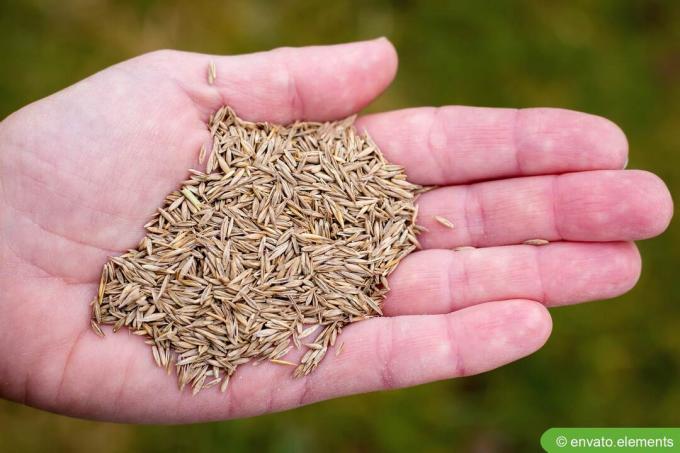
Table of contents
- Simply sprinkle lawn seed?
- risks
- That's how it works
- Beware of overdosing
- frequently asked Questions
At some point, every lawn will have one or two bare spots, which you can best close with quick overseeding. Read why simply sprinkling the lawn seed is often not such a good idea.
Simply sprinkle lawn seed?
If it's just about to close small gaps in the lawn, could the simple sprinkling of lawn seed be quite successful without prior preparation - at least if the lawn is well fertilized and watered. Also, the area should be regularly cleaned in advance scarified and aerated have been. For larger gaps, the removal of unwanted growth, such as wild herbs or moss, or even the creation of a new lawn, this procedure is not recommended.

Tip:
Also when closing small gaps you should use the soil before sowing loosen something. You don't have to dig it up for this, working with a cultivator and/or a rake is completely sufficient in this case.
risks
Grasses, especially lawn grasses, have high demands on their supply of nutrients and water for healthy growth. If the floor is not prepared accordingly, for example through regular and proper care, both can be missing and so that growth of seedlings influence negatively. In addition, there are these risks if you simply sprinkle lawn seed:
- Wind carries seeds away
- Birds eat grass seed
- Soil possibly solidified / hardened, e.g. B. due to footfall or lack of drainage
- Seedlings do not take root properly here
- no strong growth possible
- Grasses remain weak and more susceptible to Diseases and repression
- possibly previous fertilizing and/or liming necessary, e.g. B. because of soil acidification
This method is also problematic if the lawn that has already been laid shows symptoms such as moss growth, yellowing or matting shows. In these cases, simply sprinkling the seeds is not enough, as more care must be taken on the entire lawn.

Tip:
After sowing, the sown area must always be kept slightly moist so that the seed can sprout more easily. The seedlings also need moisture for their growth, but moisture must be avoided.
That's how it works
You should therefore refrain from simply scattering the lawn seed, but instead, if necessary, treat the entire lawn area carefully before sowing the gaps. This also includes the sparsely overgrown or unvegetated areas, so don't skip them! And so it goes:
- If there is thatch, comb out the surface with a rake
- scarify and aerate (e.g. B. with special shoes)
- if necessary, fertilize a few days before sowing
- if necessary (after pH test) lime
- Liming always approx. four weeks before fertilizing and sowing
- Loosen solid soil with a cultivator and rake
- Spread lawn seed by hand or spreader
- Press the seed lightly with a roller
- water thoroughly
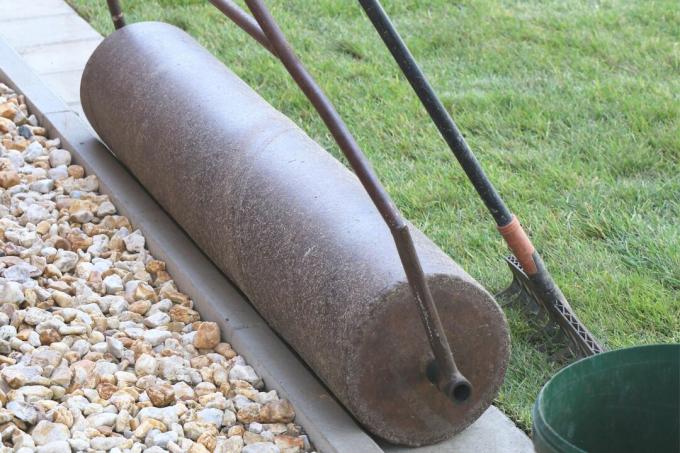
A notice:
Lawn grasses are among those light germination and must therefore under no circumstances be covered with earth. To protect against birds, you can cover the area with a translucent bird protection net. The rolling of the surface, on the other hand, protects the seeds from being carried away by the wind.
Beware of overdosing
Care must be taken when dosing the seeds: do not simply sprinkle one or more handfuls of seeds on the prepared or untreated soil, but be sure to follow the manufacturer's recommendation regarding the right amount. In case of doubt, too much seed can mean that too many seedlings develop and that they hinder each other's growth. In this way, lawn thatch quickly develops, which in turn triggers other diseases. On the other hand, if you sow too little seed, a dense lawn cannot develop.
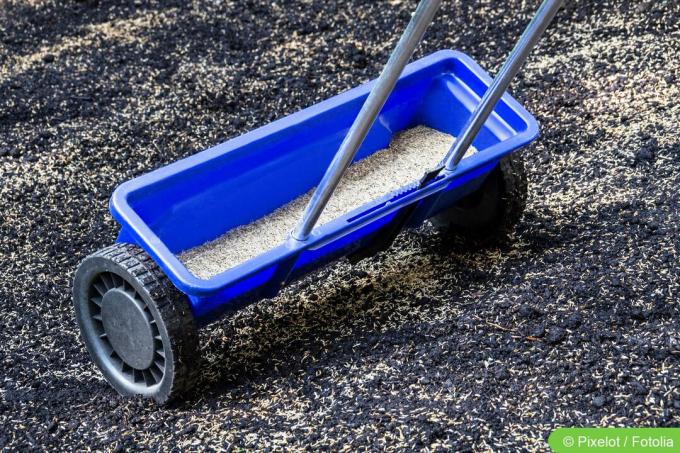
Tip:
Also, sow the seed as evenly as possible, which is difficult, especially in larger areas. A spreader helps here, which is available with and without electrical support.
frequently asked Questions
Provided the growth conditions are optimal and the soil temperature is at least ten degrees Celsius, the first grasses will germinate eight to ten days after sowing. It is fastest when the air temperature is between 16 and 23 °C and the seed surface is kept slightly moist. However, the germination speed differs between the various grasses: some grow particularly quickly, while others take a little longer. Perennial ryegrass (Lolium perenne) is considered to germinate particularly quickly.
Lawn seeds in the packaging can be kept for around three years if stored optimally - dark, dry and cool. Even after this time has elapsed, you can still sow the seed, but it loses an average of ten percent of its germination capacity per year. The older the seeds, the worse they germinate. Therefore, if possible, do not use a mixture that is too old, otherwise the desired success could not be achieved.
–
 Mirko
Mirko
Learn more about creating a lawn

When can you mow a freshly seeded lawn?
Freshly seeded lawns require some care when caring for them. This also includes not stepping on it or mowing it at first. But timely and regular trimming of the grass is crucial for dense growth.
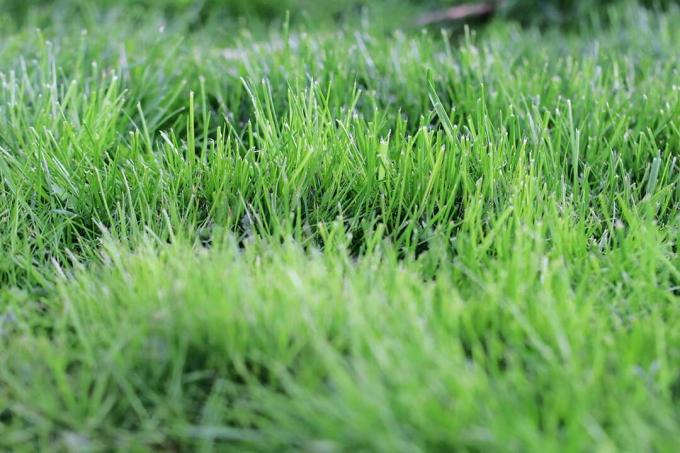
Straighten the garden and level the lawn: 11 tips
In order to be able to use your garden as effectively as possible, a flat surface is much better. Nevertheless, many floors and lawns are uneven, which makes gardening noticeably more difficult. With the right tips, you can straighten your lawn and soil.

Herb meadow: 6 tips for creating
A herb meadow is not only pretty to look at, but also very easy to care for. In this article, we will tell you how you can create a herb lawn!

Creating a flower lawn | 8 tips on seeds and care
If you want to create a flower lawn, you need patience and diligence. The effort is already worth it from the second year. Then the mixture of wildflowers and grasses blooms in colorful tones. Maintenance is reduced to a minimum in the years that follow.

Laying turf | Information on preparation, costs, timing and maintenance
If you don't want to wait long for your lawn to grow, rolled turf is a sensible alternative. But even with the pre-cultivated lawn rolls that can be laid like a carpet, there are a few things to consider. You can find helpful information about preparation and installation here.
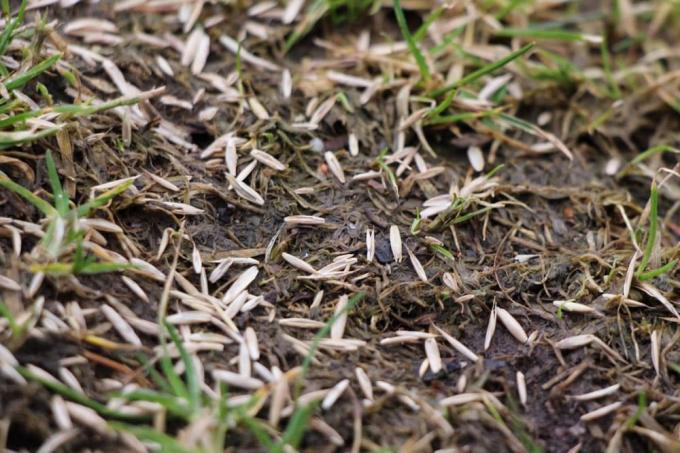
Germinating grass seeds: how long does it take for lawn seeds to germinate?
A beautiful lawn is the pride of many a gardener. Before a dense lawn has grown, the challenge is to get the grass seed to germinate. The germination time depends on various factors, including the quality of the seed.



